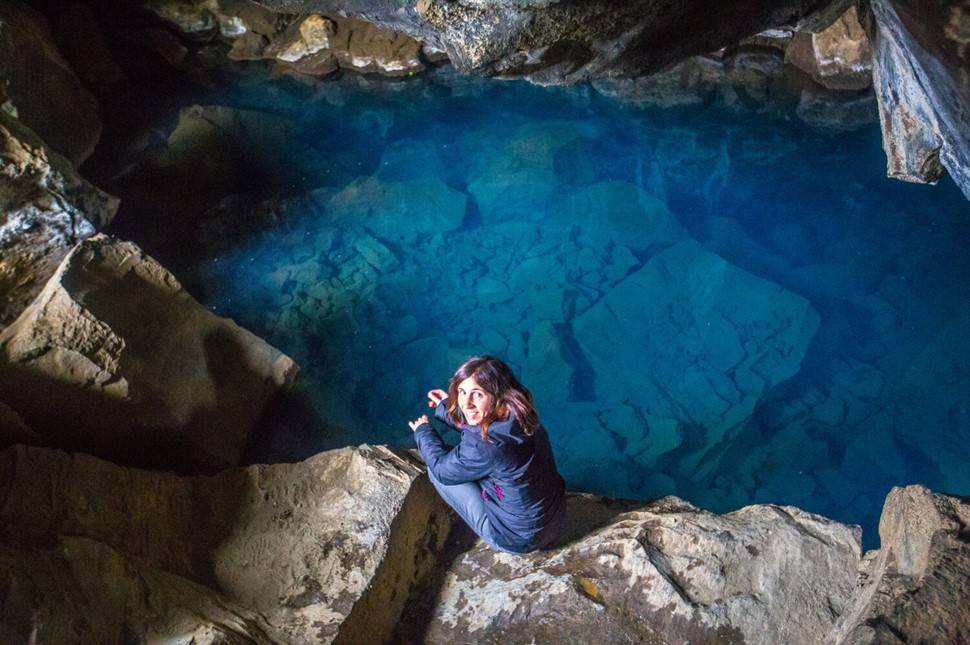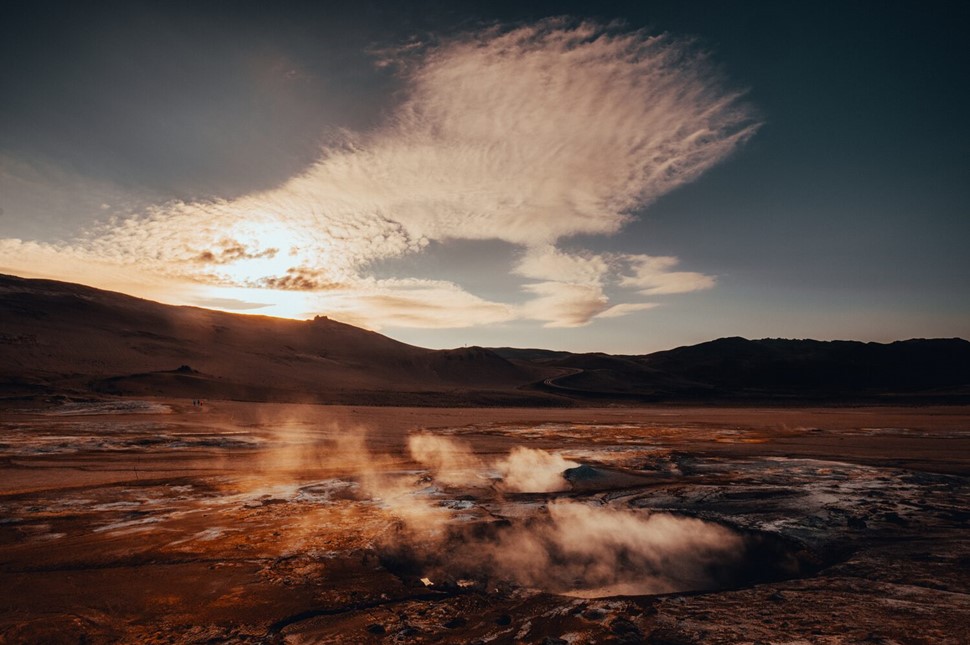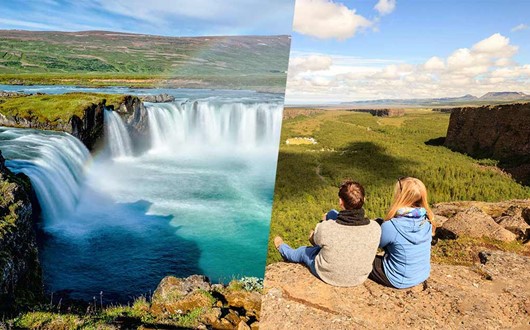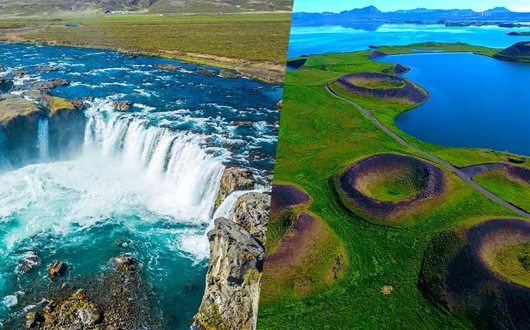Where Is Námaskarð Pass Located?
Námaskarð lies amidst the dramatic landscapes of Northeastern Iceland. The narrow pass borders on Námafjall mountain and is just a short distance from the picturesque Lake Mývatn. It's situated along the Ring Road, offering a convenient detour into the heart of Icelandic geothermal forces. It's about 493 km (306 mi) away from Reykjavík, 160 km (99 mi) from Egilsstaðir, and 105 km (65 mi) from Akureyri.
How To Get To Námaskarð Pass?
Námaskarð is easily accessible by car as it's just off the famous Ring Road (Route 1), the classic Icelandic road trip. Starting from Reykjavík, you'll reach the Namaskard Pass in six and a half hours moving clockwise.
You should expect a ten-hour trip if you drive counterclockwise due to the longer, zigzagged roads of Eastfjords. In return, you'll be able to see Iceland's South Coast and discover the breathtaking Seljalandsfoss and Skógafoss waterfalls. If you go from Akureyri, the largest town in North Iceland, it will take you only one and a half hours to reach Námaskarð.
General Information About Námaskarð
- Location Mývatn, Northeastern Iceland
- Part of The Krafla volcanic system
- Features Thermal springs, steaming fumaroles, mud pools, volcanic craters
- Elevation 400 meters (Mt. Námafjall)
- Accessibility Car
- Time to visit Year-round
- Activities Sightseeing, hiking, photography
What Is Námaskarð Known For?

Namaskard is a low, narrow pass near Mt. Námafjall and Lake Mývatn known for its rugged terrain and powerful geothermal activity. The area is scattered with thermal springs and fuming vents, which creates a mythical setting. The mixture of colors, vapors, and sulfuric smell displays Iceland's natural forces.
The pass lies in a rift valley, a place of tectonic movement, which allows hot magma to rise to the surface. This geothermal activity has created a unique and vibrant environment, both stunning and unusual.
History Of Námaskarð Area

The area's formation dates back to the Miocene epoch of 23 million years ago when the North American and Eurasian tectonic plates began separating. This rifting process created the Reykjanes Peninsula, along which Namaskard lies.
The volcanic and geothermal activity has created many thermal springs, fumaroles, and geysers. The name Námaskard comes from the Old Norse, "nám" meaning "mud" and "skor" meaning "stone land." This reflects the area's volcanic origins and the presence of mud pools and hot springs.
Námaskarð was first inhabited by nomadic people around 9,000 BC, as evident from rock carvings and archaeological sites. The first permanent settlements were established in the 11th century when the pass became an important trade route between Iceland and Norway. Today, Námaskard is a popular tourist destination and a protected area managed by the Icelandic government.
Interesting Facts About Námaskarð

A series of volcanic eruptions occurred near Krafla volcano between 1975 and 1984. These were some of the largest eruptions in recent Icelandic history and are referred to as Kröflueldar. One of the best-known craters of Kröflueldar is Leirhnjúkur, which is still active with bubbling thermal springs. It's only 15 kilometers (9 miles) north of Reykjahlíð, the most densely populated area at Lake Mývatn. Nearby is also an explosion crater called Víti, which means „Hell“.
The area's hot water and mud springs have a strong presence of sulfur that smells like rotten eggs. Some may find it inconvenient, but breathing it is considered harmless.
There is little to no vegetation growing in the area due to the ground's chemical composition and high temperature. Instead, a power station generates electricity with local hot steam, using the forces of nature to turn turbines and produce energy.
What To Do At Námaskarð?

Explore Hverarönd
Step into Hverarönd, Namaskard's geothermal hotspot known as "The Geyser Strip." Admire its colorful terrain, fuming vents, and surreal atmosphere. Keep a safe distance from the boiling-hot pools and the toxic fumes.
Conquer the Námafjall Mountain
Challenge yourself by hiking to the top of Námafjall, a volcanic mountain offering panoramic views of the surrounding Námaskarð area. The hike is relatively easy and provides stunning scenery, including the volcanic crater Hverfjall and Lake Mývatn.
Visit the Lava Fields
Explore beyond the geothermal activity and discover the surrounding lava fields produced by Iceland's volcanic activity. The lava fields have craters, lava tubes, and jagged rocks, reminding of the volcanic eruptions that created these unique formations. Just be sure to wear proper footwear and observe the safety signs.

See the Grjótagjá Cave
Visit the scenic Grjótagjá Cave, where Game of Thrones shot one of their scenes thanks to the cave's picture-perfect setting. The cave was once a natural bath due to its mineral-rich and warm waters. Today, swimming there is restricted because of the rising water temperatures.
Photograph the Experience
The unique and dynamic setting of Námaskarð makes it a photographer's dream. The changing colors, the dramatic steam, and the rugged volcanic beauty are endless inspirations for capturing great images.
Best Time To Visit Námaskarð
Namaskard is one of Iceland's year-round destinations, although summer is the most popular time for visiting. The weather is warm and sunny, with average highs between 10-16 degrees Celsius (50-60 Fahrenheit). This is the best time to see the geothermal features in full force as the steam and sulfur smells are strongest in the warmer months.
Spring and autumn are also good times to visit Námaskarð. The weather is milder, averaging 4-10 degrees Celsius (40-50 Fahrenheit). There are fewer crowds, and the landscapes are still beautiful, with wildflowers blooming in spring and leaves changing gloriously in autumn.
Winter can be a magical time to visit Námaskarð as its geothermal features are often surrounded by snow and ice. The weather can be unpredictable and harsh, so be prepared for icy roads and dress warmly for the cold.

Where To Stay Near Námaskarð?
- Vogafjós Farm Resort: This family-run farm resort is in Myvatn, just 10 minutes from Námaskarð. It offers various accommodation options, from cozy cabins to spacious apartments. The resort also has a restaurant, a swimming pool, and a sauna.
- Dimmuborgir Guesthouse: This remote guesthouse is located in the heart of the Dimmuborgir Lava Fields, about 20 minutes from Namaskard Hot Springs. It offers simple rooms and rustic cottages, most with lake views. The guesthouse features a restaurant and a sauna.
- Birkilauf Nature Lodge: This luxurious lodge is just a few miles from Námaskarð, and it offers a variety of amenities, including a restaurant, a bar, a spa, and a swimming pool. It's also a great place to experience the Icelandic wilderness with its forests and hills.
- Hótel Reykjahlíð: This charming hotel is located in the town of Reykjahlíð, a few miles from Námaskarð. The hotel is a great base for exploring local surroundings, as it has several hiking trails, waterfalls, and geothermal spots.











